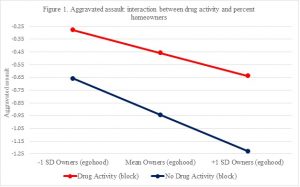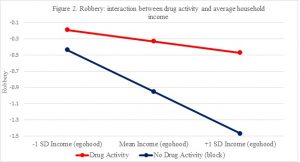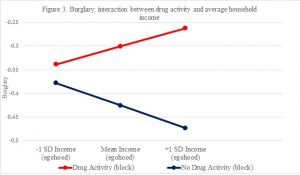To take stock of the neighborhood effects of drug activity, we combined theoretical insights from the drugs and crime and communities and place literatures in examining the longitudinal relationship between drug activity and crime rates at more spatially and temporally precise levels of granularity, with blocks as the spatial units and months as the temporal units. We found that drug activity on a block one month “pushes” assaultive violence into surrounding blocks the next month. Integrating perspectives form social disorganization theory with Zimring and Hawkins’ (1997) contingency causation theory, we also found that the economic resources and residential stability of the “the larger social environment”—that is, the surrounding quarter-mile egohood area—moderate drug activity’s block-level relationship to crime. These results suggest that drug activity increases assaultive violence and serious acquisitive crime rates on structurally advantaged blocks, producing a significant ecological niche redefinition for such blocks relative to others in Miami-Dade County, Florida.
You can access the article by Christopher Contreras and Dr. John R. Hipp online first in Justice Quarterly entitled, “Drugs, Crime, Space, and Time: A Spatiotemporal Examination of Drug Activity and Crime Rates”.
Get it here:
https://www.tandfonline.com/doi/full/10.1080/07418825.2018.1515318
Abstract:
To take stock of the neighborhood effects of drug activity, we combined theoretical insights from the drugs and crime and communities and place literatures in examining the longitudinal relationship between drug activity and crime rates at more spatially and temporally precise levels of granularity, with blocks as the spatial units and months as the temporal units. We found that drug activity on a block one month “pushes” assaultive violence into surrounding blocks the next month. Integrating perspectives form social disorganization theory with Zimring and Hawkins’ (1997) contingency causation theory, we also found that the economic resources and residential stability of the “the larger social environment”—that is, the surrounding quarter-mile egohood area—moderate drug activity’s block-level relationship to crime. These results suggest that drug activity increases assaultive violence and serious acquisitive crime rates on structurally advantaged blocks, producing a significant ecological niche redefinition for such blocks relative to others in Miami-Dade County, Florida.


